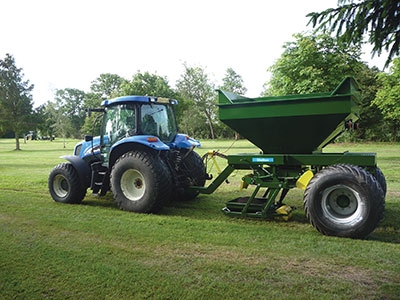
Features
Drainage Management Systems
Big impact, low cost
Strategies for sportsturf drainage systems.
May 7, 2014 By David Shelton
 The Shelton Fast-flow machine backfills narrow trenches with gravels and sands at forward speeds of up to five miles per hour. Most cost effective
The Shelton Fast-flow machine backfills narrow trenches with gravels and sands at forward speeds of up to five miles per hour. Most cost effectiveMost cost effective, most efficient, most economical – this is the end game for management consultants in their efforts to improve processes and save money in any business.
With this in mind, what is the most cost-effective, most efficient and most economical way of draining sports turf? Unless the site is free-draining, some form of pipe work will be necessary to carry the water away. But what size? At what depth? What trench width and trench spacing? Some may say bigger is better, and others will disagree. Is there a right way to maximize effectiveness and efficiency while minimizing cost?
Trench width
We have seen time and time again that the most cost-effective system is one using the smaller-diameter land drainage pipes fitting snugly in trenches, filled to the surface with free-draining aggregates.
When excess soil water enters the land drainage pipe, very small particles of soil also enter. When there is a good flow of water through the pipe, these particles, called fines, are carried along and eventually exit the system. However, if too big a pipe is used, the water flow through it is sluggish and the fines settle out, slowing building up and constricting the pipe size (and, consequently, its effectiveness).
Hence, using unduly large pipe can be a waste of money. Not only does the pipe cost more, but it also means digging a wider trench, which in turn leads to the need for substantially more free-draining back-filling aggregates.
The following example compares the installation of two-inch vs. four-inch diameter tile on a 300- by 150-foot pitch.
Notes: Trenches need to be dug a little wider than the diameter of the pipe because they become narrower soon after being dug due to the latent forces in the ground. The excavated soil has to be carted away. In the loose, it is approximately 50 percent more bulky. Normally two different back-filling aggregates will be specified, so two passes with machinery will be required.

Trench spacing
The use of the pitch will normally determine the spacing of the drains. A professional pitch will need speedier drainage than that used by a school. In the case of a soccer pitch occupying a 300- by 150-foot area, if one inch of rain falls on it in an hour and the soil is close to capacity, the pitch can only absorb 6,000 gallons. The drainage scheme has to cope with 23,350 gallons of water from that rainfall.
On a school pitch, two-inch pipes are used running across it at 30-foot intervals. Each of 11 runs will have to evacuate 2,122 gallons of water. On a professional pitch, also using two-inch pipes, the trench spacing will be at 15-foot intervals. Each of 21 runs will have to evacuate 1,111 gallons of water.
The types of back-filling aggregates used have a bearing on the speed at which the excess soil water reaches the pipes. Round aggregates drain more quickly than crushed aggregates because there is considerably more pore space.
Trench depth
The depth of the land drains should allow for 16 inches of the top soil to remain unsaturated. Installing drains too deep can lower the water table to such an extent that irrigation becomes necessary sooner.
The advent of specialist machinery
In the 1970s, a pitch would have been drained using a self-propelled agricultural drainage machine on tracks. These machines dug wide trenches and placed the excavated soil at the side of the trench, to be cleared up later in the operation. Upheaval was substantial, and it was usual to allow 12 months before re-use. Small, self-propelled chain trenchers, which cut trenches over four inches wide, similarly depositing the spoil on the trench side, were also popular. They made less damage to the playing surface, but nevertheless, re-instatement was measured in months. Both methods resulted in wide trenches, soil-contaminated turf and months of recovery time – factors that often challenged the viability of carrying out drainage work.
In the early 1980s, the three-point linkage, tractor-mounted wheel trencher brought new promise. The high-speed cutting disc cut clean, two-inch-wide trenches, which acted like mini-ditches. These machines were initially used in agriculture but those involved in draining sports fields soon saw the advantages for draining fine turf. The Shelton business then developed an enclosed trencher with a conveyor to load the excavated soil into a trailer running alongside; they further developed the machines to cut trenches from one- to six-inches wide.
With new technology, the optimal width of a trench can be dug precisely; the elevators on the trenchers convey the excavated soil into tractors and the sod is left clean. Re-instatement of the narrow trenches can be done by seeding.
It is now possible to drain today and play tomorrow, and this greater efficiency has resulted in lower costs.
David Shelton is the founder and former managing director of Shelton Sportsturf Drainage Ltd in the U.K.
Print this page